An easy cultured vegan yogurt recipe that's smooth, tangy, exceptionally thick & creamy, and perfect for dolloping on anything and everything! Easy to make with or without an Instant Pot.
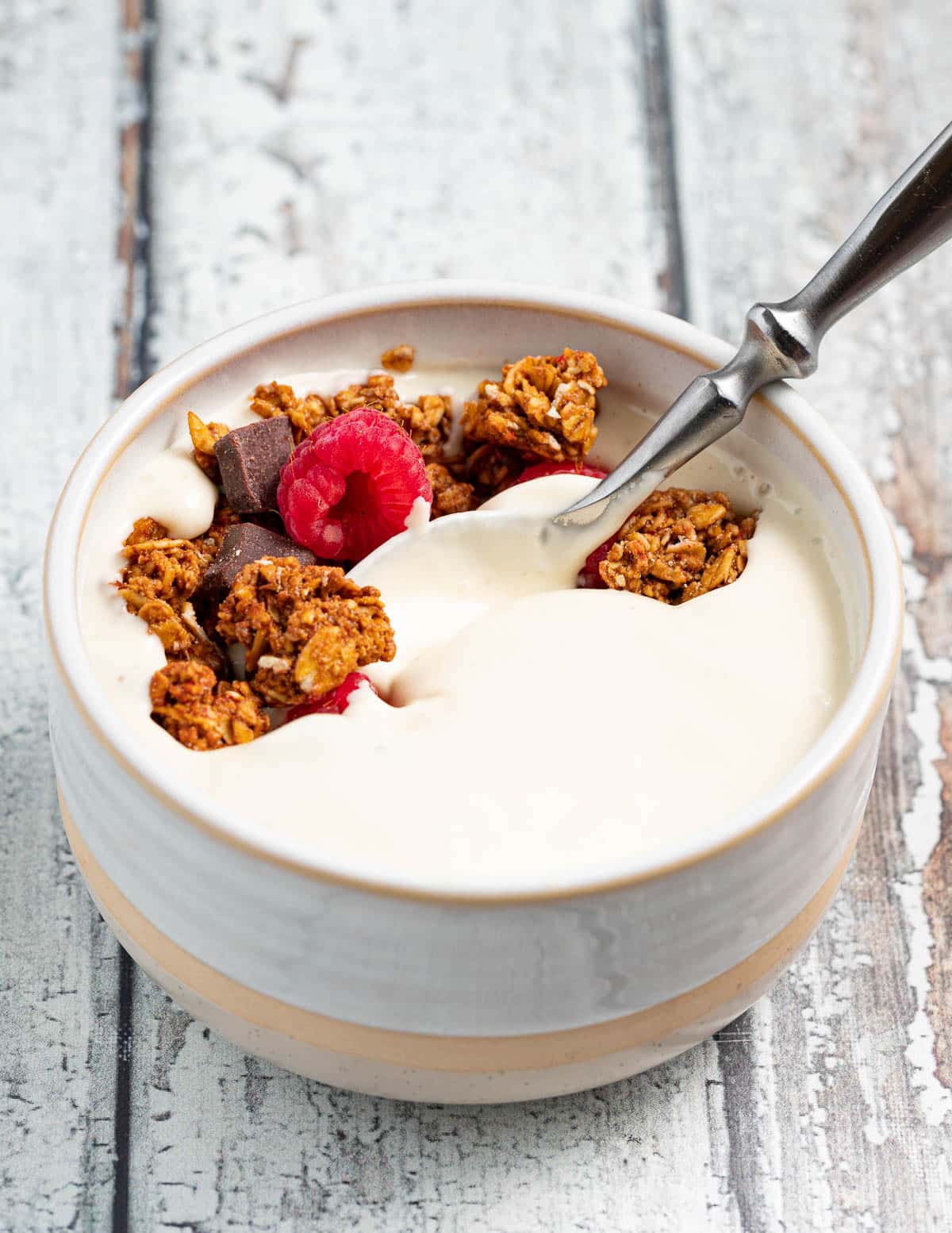
💌 SAVE THIS RECIPE!
Watch out for more tasty treats coming your way too! Unsubscribe at any time.
We're jumping back on the fermentation train for this vegan yogurt recipe. And it's a whole lot quicker and easier than making a sourdough starter or sourdough bread so you're A-Ok!
And this vegan yogurt is so good! We're talking sheer yogurt decadence. It's smooth and tangy, and unlike many other homemade vegan yogurt recipes, it is exceptionally thick and creamy.
Yep, this cultured vegan yogurt recipe is THICK. And it continues to thicken as it sits in the fridge. If you leave it there for a few days it becomes almost Greek yogurt-like. And you won't need any expensive probiotics, powdered starters, or thickeners like agar, tapioca, or xanthan gum to make it either!
Mel x
Jump to:
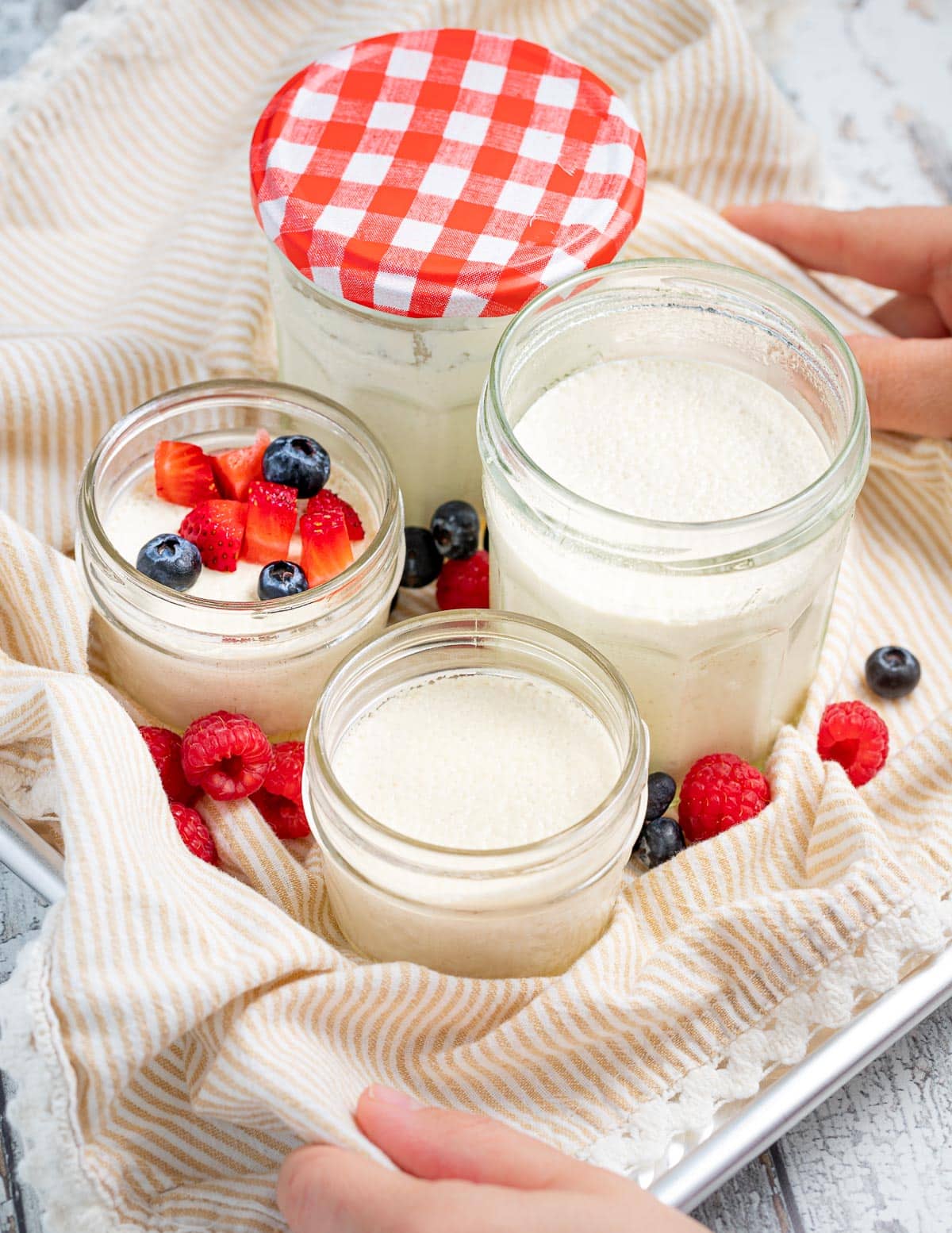
Ingredients
Are you wondering how you can possibly make vegan yogurt without probiotics or special yogurt starters? I'll let you in on my secrets.
These are the ingredients you need to make my vegan yogurt recipe and a little about why you need them:
- Light canned coconut milk - Light canned coconut milk gives consistent results and makes the yogurt rich, decadent, thick, and creamy without an obvious coconut taste. I do not recommend you use any other milk.
- Raw cashew nuts - These add a lovely cashew flavour and also work to make this yogurt extra thick and creamy.
- A tiny bit of store-bought vegan yogurt - This acts as the starter. It contains the live cultures that will ferment your yogurt. You only need this the first time you make it. For subsequent batches, you can use a little of your homemade vegan yogurt instead.
- Maple syrup - Maple syrup is always my first choice because it is so natural and unprocessed, but agave or white/cane sugar will work too. Sugar in some form is necessary for the bacteria to feed on. It won't make your yogurt sweet because by the time it is cultured the bacteria will have consumed it.
You will also need some glass jars with lids. I use cleaned up empty jam jars. I don't recommend making this recipe directly in the inner pot of an Instant Pot.
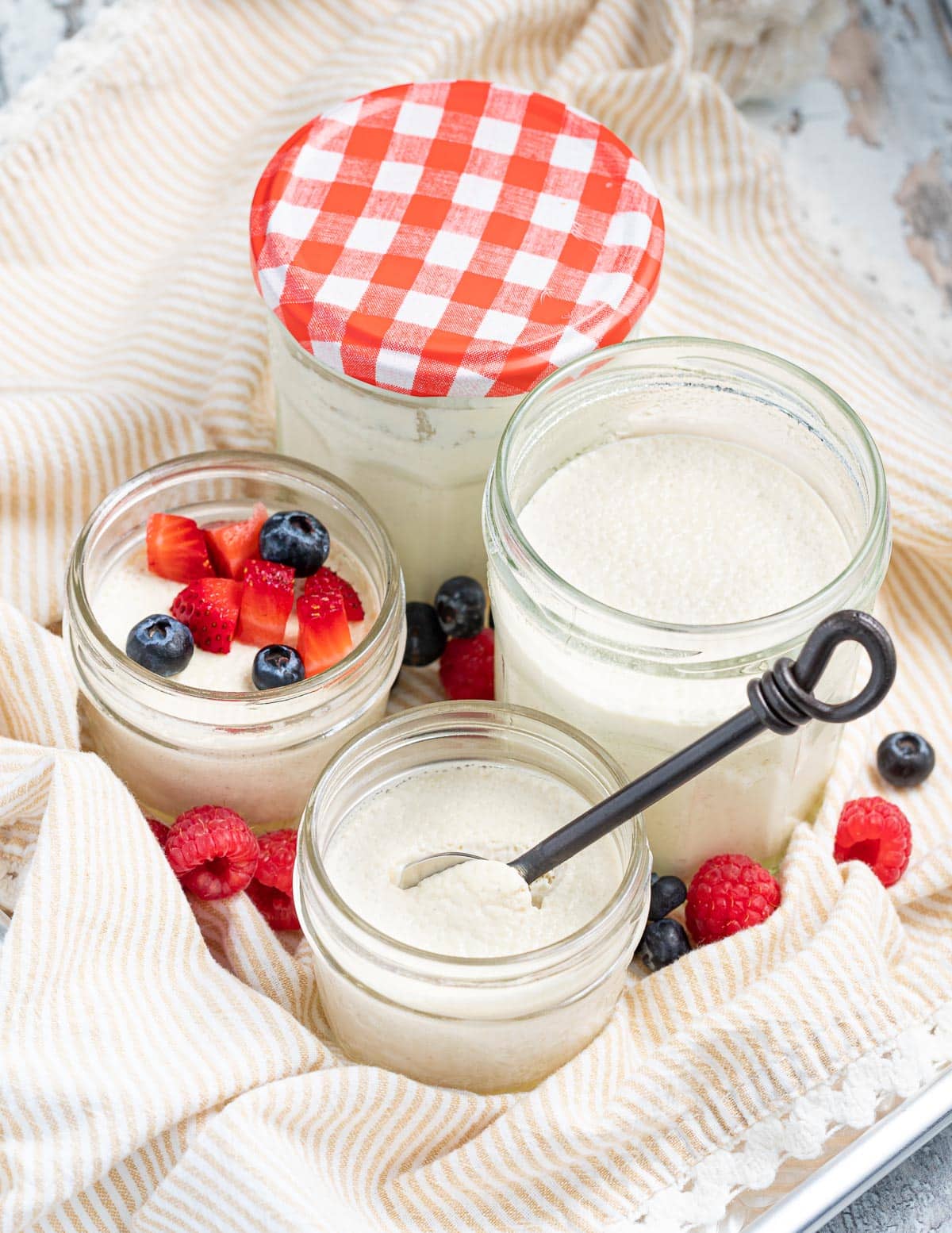
Do I Need An Instant Pot To Make Vegan Yogurt?
An Instant Pot with a designated yogurt button provides the perfect environment for making this vegan yogurt recipe and it is the quickest method too. You don't have to use one though. You can make it without an Instant Pot and instructions are included.
How To Make Vegan Yogurt
Want to know how to make the best vegan yogurt? It's much easier than you might think and you can make it with an Instant Pot or without one.
Here's exactly how it's done with step-by-step pictures:
1 - Soak the cashews then add them to a blender with the other ingredients. Blend until completely smooth.

2 - Decant into jars then place in an Instant Pot on the yogurt setting or leave in a warm place to ferment.

3 - Chill thoroughly before serving. When you remove it from the fridge it will be very thick. The longer you leave it there the thicker it will get. Here's what it will look like when you first spoon some out:

4 - Stir it and it will become super, silky smooth like this:
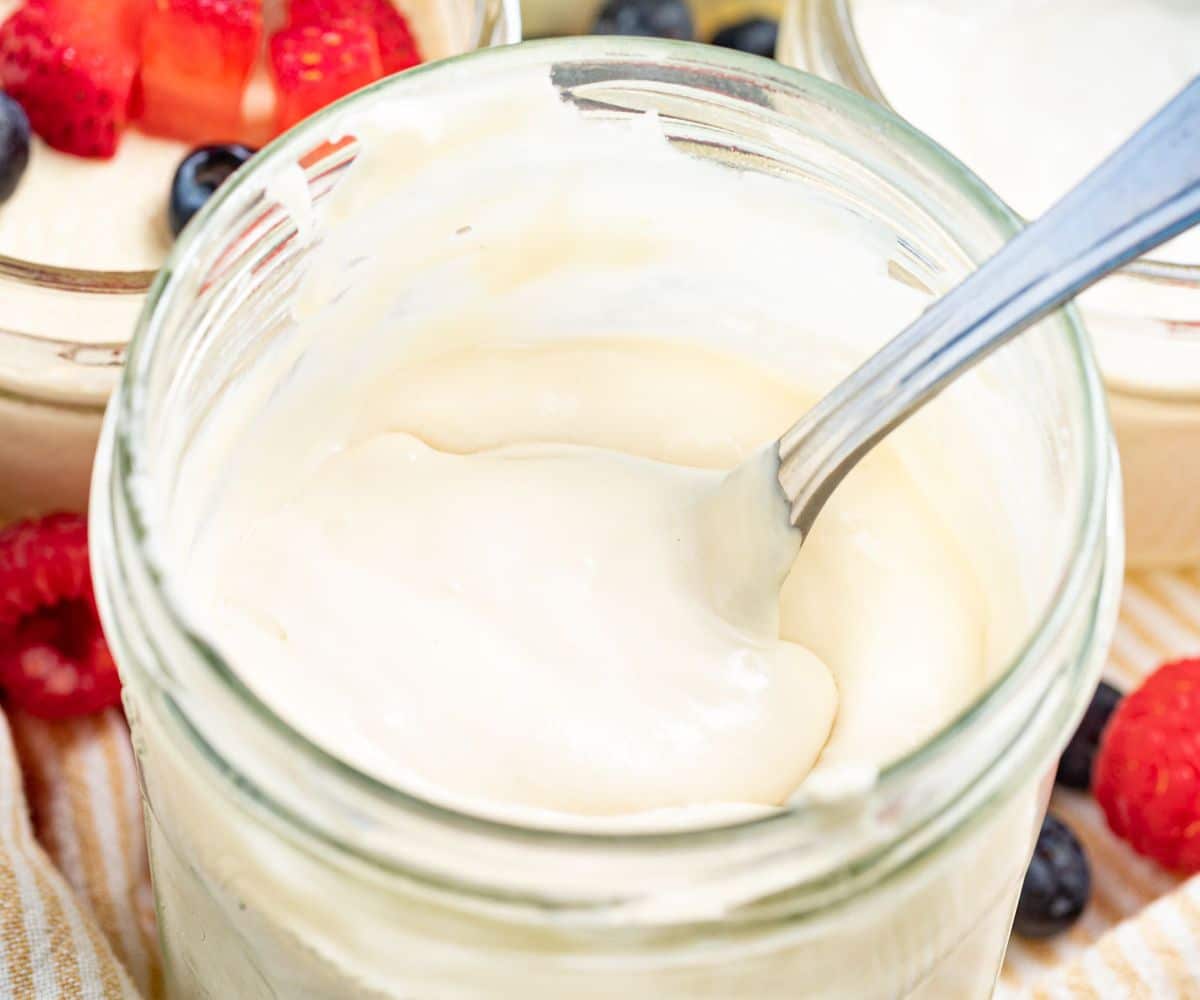
IMPORTANT! Before you eat it all remember to save a few tablespoons of yogurt to culture your next batch!
How To Culture Yogurt Without An Instant Pot
The easiest way to incubate and culture your homemade vegan yogurt is with an Instant Pot that has a yogurt setting. That will keep it at a consistent temperature with no effort from you. And it's no secret that I love my Instant Pot. I use it for something nearly every single day, including recipes like my Instant Pot Black Beans, Instant Pot Portobello Pot Roast and Instant Pot Tomato Soup and also for cooking rice, grains, and oatmeal, etc.
A yogurt maker will work well too and if you don't have either of those then you will need to keep your yogurt at a temperature of between 29 ° C (85 ° F) and 46 ° C (115 ° F). Anything below 29 ° C (85 ° F) and you'll have trouble getting it to culture.
It is also really important that the yogurt doesn't get close to or above 49°C (120 °F) because at that temperature the yogurt cultures will start to be killed off and the recipe won't work. Because of this I highly suggest you check the temperature of the yogurt's location with a thermometre before you start incubating it if you aren't using the controlled environment of an Instant Pot or yogurt maker.
Here are some suggestions for ways to keep your yogurt warm so it cultures successfully:
- Warm house? - If your house is around 29 °C (85 °F) or more you can leave the covered jars on your countertop away from direct sunlight and in a spot where they won't be disturbed.
- In your oven - Preheat your oven to 200 ° C (400 °F) for 1 minute then turn it off. Sit your jars on a baking tray and place them in the oven on the top shelf with the oven light on. Do not open the door for at least 10 hours or the heat will escape.
- Use your home heating - Place your jars of yogurt near (but not too near) the furnace, radiator, fireplace, and stove.
- On top of your fridge/fridge freezer - This is usually a nice warm spot and works well if you don't have built-in appliances.
- In the airing cupboard - If you are in the UK in an older house you might well have one of these.
- A warm closet - I have forced air heating in my house and the closets have vents inside that keep them warm. A spot like that would be ideal.
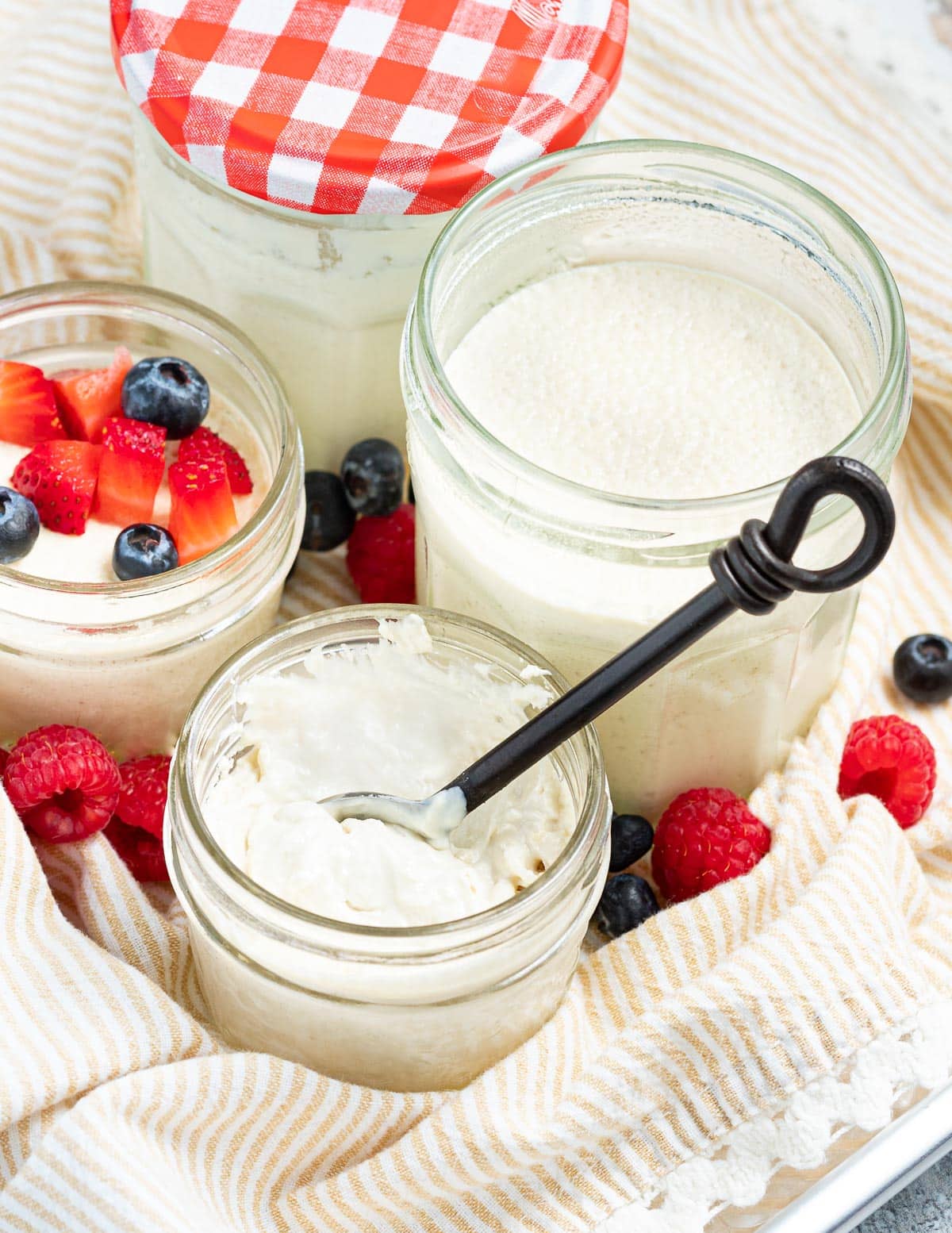
Yogurt Success Tips
- Follow the recipe exactly. Vegan yogurt is finicky. If you make any changes at all it might not work.
- Be sure to soak the cashews even if you have a high-powered blender. We want this yogurt super-duper smooth.
- Do not omit the sweetener. It is necessary for the bacteria to feed on.
- Canned light coconut milk should be used to make this vegan yogurt recipe. I don't recommend using full-fat coconut milk as it will make the yogurt too firm and it also tends to cause separation. Don't be tempted to buy full-fat canned coconut milk and dilute it yourself to make "light" coconut milk. That will not work in this recipe.
- Ensure the yogurt you use to "seed" your yogurt is a cultured/live one. Most are but double-check. If you don't like the results using a particular brand of yogurt try another one next time. Better quality yogurts will give better results.
- Makes sure everything is very, very clean.
- For this recipe, I recommend incubating the yogurt in glass jars. I do not recommend you make it in one big pot, like the Instant Pot's inner pot. This is because this yogurt gets the very best texture when it is completely undisturbed while it incubates and chills. If you stir it or disturb it you will lose the lovely thick, creamy texture.
- If using an Instant Pot do not set your jars on the trivet. They need to be directly in contact with the inner pot. Don't use the trivet at all.
- Don't use metal utensils, pots or bowls as there's a small chance prolonged contact with them could harm the bacteria in the yogurt.
- Try not to disturb the yogurt in the jars. It gets much thicker if you leave it well alone.
- I like to make my yogurt just before I go to bed. That way the incubation time happens while you sleep.
How To Flavour Homemade Yogurt
I don't recommend adding anything before culturing your vegan yogurt because it might hinder the process, but after it has cultured and chilled and you are happy with the tanginess feel free to stir through:
- vanilla or other extracts and liquid sweeteners such as maple syrup
- roasted strawberries, fruit jam, conserves, or fresh fruit
- vegan lemon curd, blueberry lavender sauce, or frozen berry compote
- defrosted frozen berries
- date caramel
- stewed or canned fruit, applesauce, or apple butter (I have recipes for Instant Pot Apple Butter, Stovetop Apple Butter, and Slow Cooker Apple Butter).
Serving Suggestions
Uses for vegan yogurt are wide and varied. I suggest keeping a jar in the fridge at all times so that you can eat it on repeat for breakfast, snack, and dessert!
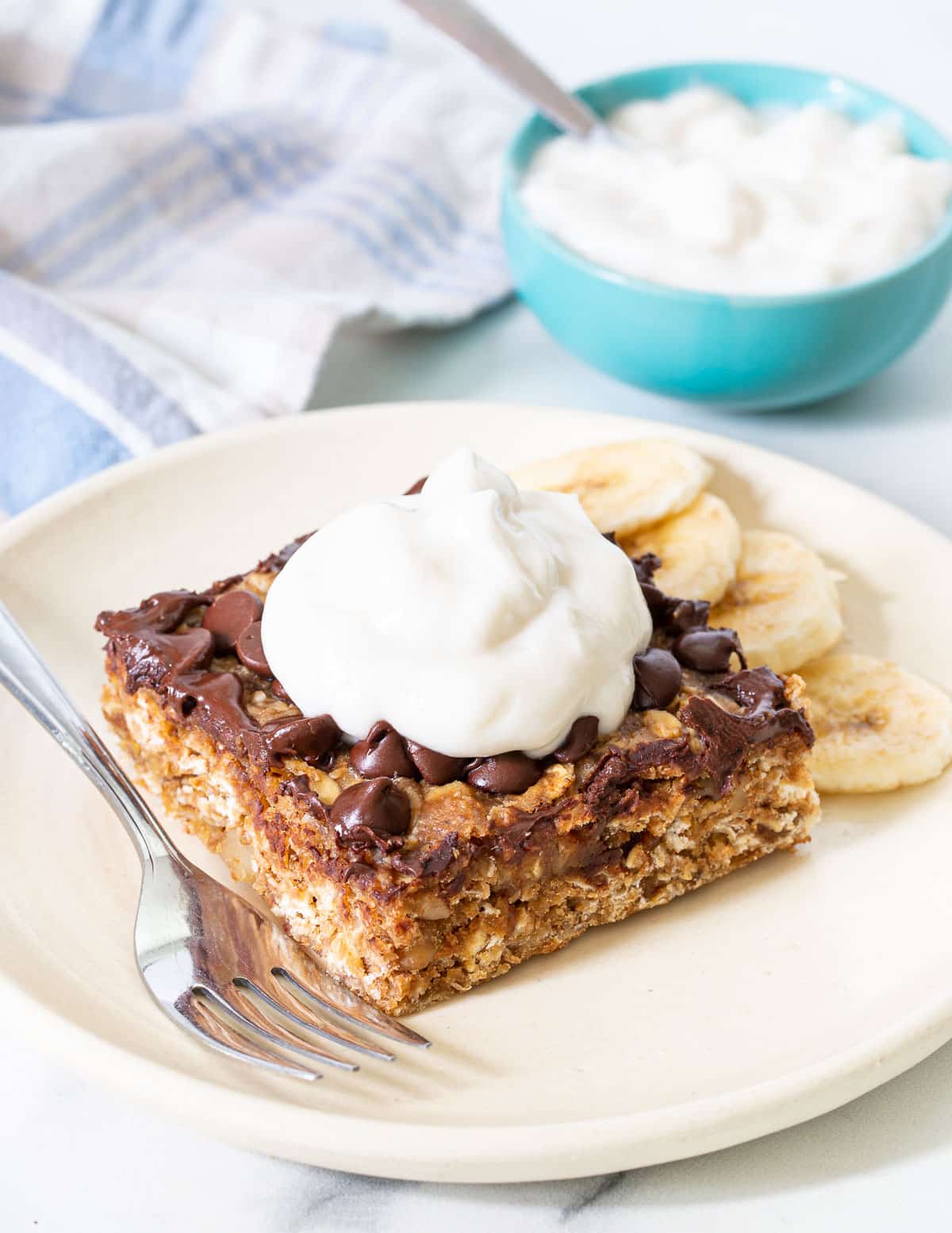
My favourite ways to enjoy yogurt include:
- With spicy curries like my Chickpea Lentil Curry or Red Lentil Dal.
- In my Emergency Strawberry Cheesecake Bowl and Cheat's Banoffee Pie Bowl.
- In Bircher Muesli or my Emergency Strawberry Cheesecake Bowl
- On pancakes or waffles or healthy breakfast bars (pictured above).
- In smoothies
- With vegan granola or chocolate coconut granola and fresh fruit
- As an ingredient in sauces, dips, and baked goods like my Vegan Apple Cake recipe.
What Makes This Yogurt So Thick & Creamy?
If you've made vegan yogurt in the past you've probably found that it usually turns out quite thin and you might be wondering what you can do to thicken your homemade vegan yogurt.
It's hard to make thick vegan yogurt without adding a thickener of some kind. Store-bought vegan yogurts all contain them. The most common thickeners are agar, tapioca flour, or xanthan gum.
In this recipe though we blend soaked cashew nuts into the light coconut milk to naturally thicken the yogurt. The combination of the creamy canned coconut milk, the cashews, and the fermentation process makes it a really thick and creamy vegan yogurt.
Recipe FAQs
Most vegan yogurt contains the same gut-friendly probiotics that non-vegan yogurts do, including this recipe, which when made the first time is "seeded" with probiotics from a store-bought yogurt and then cultured.
Not at this time. I have only tested this yogurt with cashew nuts. If you use anything other than cashew nuts I cannot guarantee that the recipe will work. I think it should work if you omit the cashews but the yogurt will be much thinner. Please note that I have not tested it that way though so if you try it you do so at your own risk.
A lot of plant-based milk will not make successful yogurt. This recipe works well and consistently when using light canned coconut milk. I do not recommend using any other milk as there is a good chance it will not work well or even at all.
There is a chance that despite your best efforts you might get some separation occurring. Just stir it in and pop the jar back in the fridge. Often that's enough to get it to stay nicely homogenized.
If there's a lot of separation you have 2 options:
Scoop off the creamy top, put it in a clean jar and discard the watery part.
Strain it. Line a sieve with cheesecloth and sit it over a bowl. Pour in the yogurt and cover the top with a clean, fluff-free cloth or more cheesecloth. Place the whole thing in the fridge for 24 hours. The liquid will slowly drip out into the bowl leaving you thick and creamy yogurt in the sieve. Once 24 hours have passed, scoop the creamy yogurt into a lidded jar.
Use it in place of milk, sour milk, sour cream, buttermilk, evaporated milk or yogurt in any recipe. Add it to smoothies. Use it as the liquid in pancakes, waffles, cakes or muffins.
If it smells funky (cheesy or foul) or if there is any mould in it then it is important you don't eat it. Discard or compost it.
This is likely either temperature related (it was too warm or too cold), the yogurt you used to "seed" it wasn't a live one with probiotics in it, or the yogurt you used to "seed" it wasn't stored correctly either before or after you got it and the bacteria were no longer active.
Sugar is necessary for the bacteria to feed on so you need to add it in some form. Agave or white or cane sugar will work. Don't use dark-coloured sugar because it will affect the appearance of the yogurt.
Did you omit the maple syrup? This is necessary for fermentation. Without it the bacteria will start dying off before the fermentation process has completed. When this happens an "eggy" sulphur smell can occur. Not sterilizing things properly can also cause issues.
Recipe
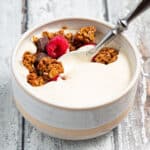
Vegan Yogurt Recipe
Author:Ingredients
- 1 cup (140 grams) raw cashew nuts
- 1 standard can (400ml / 13.5 oz) light canned coconut milk (this recipe won't work well with any other milk)
- 2 tablespoons vegan yogurt , It must contain live probiotic cultures. Note that you only need store-bought yogurt the first time you make this recipe. For subsequent batches, you can use your homemade yogurt.
- 2 tablespoons maple syrup , or agave or the same amount of white or cane sugar (do not omit)
RECOMMENDED EQUIPMENT
INSTRUCTIONS
- Make sure everything you will be using is scrupulously clean. I run my glass jars, and lids through the dishwasher on the hottest setting. You can also wash them in hot soapy water and put them on a baking tray in an oven at 135 °C (275°F) for 15 to 20 minutes or clean the jars in hot soapy water, rinse them, then put them still drippy and wet into the microwave. Microwave on high for 45 seconds (do not put metal lids in the microwave - Soak them in boiling water). I also wash my blender jar in hot soapy water, then rinse and fill it with boiling water, let it sit for a few minutes then pour it out.
- Put the cashews in a small bowl and cover them completely with boiling water. Leave them to soak for 20 to 30 minutes. Don't skip this step.
- Run boiling water through your sieve then drain the cashews and add to a blender. Add the light coconut milk, yogurt, and maple syrup. Blend until completely smooth.
- Decant the mixture into clean and dry glass jars. You cannot make this in the metal Instant Pot insert. Any combination of jar sizes that will hold a total of about 600ml (just under 3 cups). Make sure the jars you choose fit easily together inside the metal inner bowl of the Instant Pot before you start filling them.
- If using an Instant Pot - Place the uncovered yogurt filled jars into the metal inner pot of the Instant Pot. Do not use the trivet and do not add any water to the pot. The jars should be in direct contact with the bottom of the pot and have no lids or other covering on them. Place the lid of the Instant Pot on and close it, then close the steam vent. Press the yogurt button (check that the display says "normal" and not "boil", then adjust the time depending on how long you would like your yogurt to ferment. I suggest a minimum of 10 hours. That will give you a nice thickness and a slight tang. 11.5 hours will give you a more pronounced tang. Do not disturb the Instant Pot/yogurt during this time. You can check it after 10 or 11 hours though. Use a spoon to take a little bit from one jar (without stirring it up first)and taste it. Put the Instant Pot back on again for another hour or two if it's not quite tangy enough.
- If you don't have an Instant Pot - Cover the filled jars with cheesecloth, clean fluff-free dish towels/cloths, any clean breathable fabric, or paper towels and elastic bands or string to hold it in place. To culture successfully you need to keep the yogurt at a consistent temperature of anywhere between 29 ° C (85 ° F) and 46 ° C (115 ° F). If your house is 29 °C (85 °F) or more you can leave the covered jars on your countertop away from direct sunlight.If your house is cooler than that, turn your oven to 200 ° C (400 °F) for just 1 minute and no longer. Then turn it off and turn the oven light on. Place the covered jars on a baking tray (for stability) in the oven on the top shelf, with just the oven light on. Do not open the door while it is culturing or you will let the heat out. Also make sure that no-one turns the oven on. A note stuck to the door is a good idea. Do not disturb the yogurt while it is culturing. At 38 ° C (100 °F) the yogurt will take between 10 to 12 hours to culture, thicken nicely and get a good tang. If the temperature is cooler than that it will take longer and if it's warmer then it will happen more quickly. I suggest testing it by scooping a tiny bit out and tasting it after about 10 hours, then add on more time if you want it to be tangier. If you don't use an Instant Pot or yogurt maker which will control the temperature and keep it consistent, I would highly suggest you check the temperature of your chosen location with a thermometer. It is really important that the yogurt stays consistently between 29 ° C (85 ° F) and 46 ° C (115 ° F). If it doesn't the recipe will not work.
- Once the yogurt has incubated and has reached the right amount of tanginess for you, cover securely with a lid and refrigerate thoroughly. Do not stir it. For best results it needs to be undisturbed until completely chilled. It will thicken more as it chills and will continue to thicken the longer you leave it before eating.
- Remember to save a few tablespoons of your yogurt so that you can use it to culture your next batch of homemade vegan yogurt.
- If you prefer a sweet yogurt, add more sweetener after the yogurt has fermented and chilled and not before.
NOTES
💌 SAVE THIS RECIPE!
Watch out for more tasty treats coming your way too! Unsubscribe at any time.


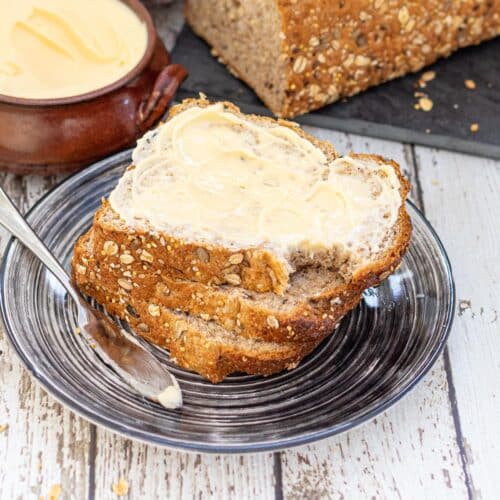
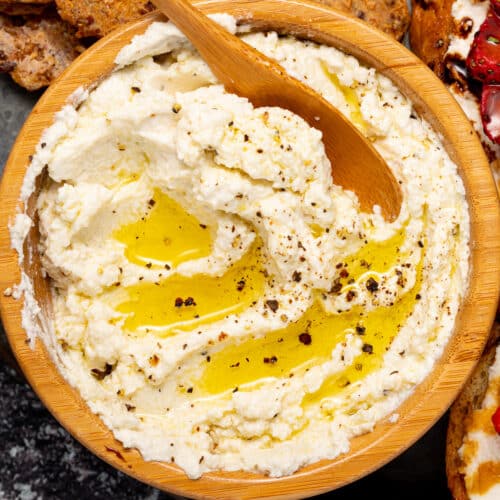

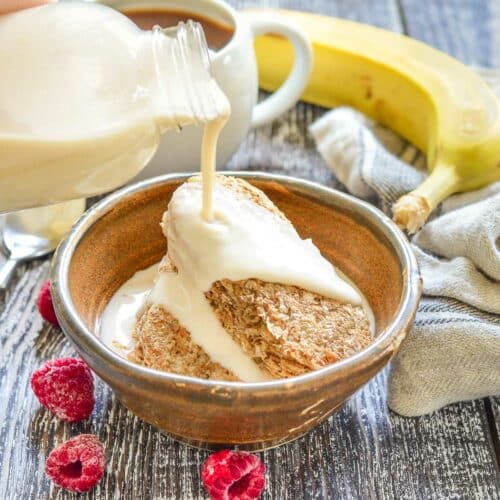
Charissa says
Also, I wanted to add that I use the Cha's Organic Coconut Milk (it's definitely not the light one - I think it's the premium) and my recipe turns out great each time. I personally don't mind it slightly thicker, and yes, it does separate at the bottom. There's always about 1/2" of liquid at the bottom that I just stir back into the yogurt once it's chilled and it turns out just fine. Just for anyone else wondering, it is an option, you just need to stir the yogurt up. It turns out super thick, almost more like a spread than a yogurt, but I don't mind that personally.
Charissa says
I've been making this yogurt recipe for months now. Love it so much and my family does too. Very simple and delicious.
I'm having one problem, more recently.
I make it the same way every time, although I just eyeball the amount of maple syrup and starter yogurt I add in each time. However, lately, the yogurt has been bubbling up SO much and spilling over into my instant pot before the 11 hours is up. (I found I like the yogurt best at 11 hours)
So what am I doing wrong?
I always make a doubled batch and that was never an issue, but perhaps am I adding too much syrup? Or too much yogurt starter? The original recipe called for 2 tbsp of each so I've normally been adding 3-4 tbsp of each, but is that too much? The yogurt still turns out every time and tastes great, but it makes a big sticky mess, even when I leave 1.5 inches of room in the widemouth jars. (a double batch makes 4 500ml jars for me that are not completely full).
Melanie McDonald says
Overflowing like this could be caused by a few factors. Overfermentation, heat too high, contamination, excessive sugar or starter or additives. If it was fine before then something you are doing or in the environment has changed and only you can figure out what that is. The obvious thing though is that you say you don't measure and just eyeball. This is likely to be the reason if no other factors have changed. Hope that helps!
Sharon says
Hello, I want to make this yogurt for my 4 year old. We just found out she has a dairy allergy and she loves vanilla yogurt. Can you add vanilla to this recipe or any other fruits or flavorings? Thank you.
Melanie McDonald says
You can add flavorings after you've made/cultured the yogurt. Don't add them before as it will affect the fermentation. I give lots of ideas in the post here: https://avirtualvegan.com/vegan-yogurt-recipe/#how-to-flavour-homemade-yogurt
Hope they enjoy it!
Sharon says
Thank you. I guess I should read the whole thing instead of skipping right to the recipe and directions!!
Melanie McDonald says
Ha ha, yes you should!🤭 I always try to cover as many questions as I can in my posts and if there's something that people keep asking after a recipe is published I go back and add it to the FAQs. I try to make my recipes/posts as detailed and helpful as possible because I want everybody to have the best results possible. Enjoy the recipe!
sandy says
Hi, would almonds or macadamia nuts work in place of cashews please.
Melanie McDonald says
I haven't tried it but I think either should be fine.
Nancy says
This looks like a great recipe for me. Is it possible to switch the maple syrup with date syrup!
Melanie McDonald says
Sorry, I've never tried it so don't know.
Tiffany says
Super great recipe! Followed exactly using my yogurt maker with individual glass containers at 107°F for 11 hrs. Perfect consistency and there was definitely the tang in the taste. (This was my second time making it. I adjusted the temp the second time to achieve what I wanted.) Will be making this on repeat!
Melanie McDonald says
So pleased you are enjoying it Tiffany. Thank you for coming back to leave a review. It's much appreciated!
Connie says
So I really loved this recipe! However I’m wondering why you can’t use full fat coconut milk.
Melanie McDonald says
It doesn't work as well or as consistently. The yogurt separates too much.
Cindy says
This was easy to make and absolutely delicious. I have tried many vegan yogurt (usually soy based) recipes, sometimes successful and sometimes not. I will definitely be making this again!
Cindy says
can I use regular canned unsweetened coconut milk (not light)?
Melanie McDonald says
No you need to use light coconut milk for this recipe. It doesn't work well with full fat and will separate.
Joanne says
I have made this recipe twice, the first time I had some separation after 12 hours and the second time it was fine after 10 hours. My problem is that I can’t seem to make it thicken. I’m using Cole’s brand light coconut milk but it is still a pourable yogurt like melted icecream and the cashews are blended so it is quite creamy just runny! What am I doing wrong?
Melanie McDonald says
Are you using an Instant Pot with the yogurt function? If not have you checked the temperature it's fermenting at to make sure it's in the correct range? Is there a chance you're not fermenting it long enough or for too long? The time it needs will vary and over or under fermenting it will make it thin.You could also try another brand of yogurt to seed it or increase the amount of cashews.
Joanne Rollason says
I’m using the Insta pot function, the first time for 12 hours and the second time for 10 hours as it was a little too tart
Julie Hover says
We love, love, love your yogurt recipe and make it a couple time a week. The only change is that we triple the recipe and omit about 1/2 teaspoon or so of the maple syrup (although we liked the yogurt with the full amount of syrup when we made the single amount). It tastes better than any store bought yogurt we have ever tried. Julie H.
Melanie McDonald says
I'm so pleased you're enjoying the recipe, Julie!
Ginny Bates says
Have you been hearing/reading about L. Reuteri cultured dairy? Technically, it cannot be called yogurt. It is supposed to be excellent for many health concerns. Dr. William Davis has written a book about this "super food". Unfortunately, the recipe calls for half n' half, a dairy product. There are non-dairy versions that use cashews and/or coconut milk and a rather lumpy one with oats. The problem I have with these is the high level of fat (not the oat one) and calories. I like my yogurt to be creamy, sure, but not add so many extra calories to my diet. I've been experimenting with soy milk, some coconut milk, and cashews, along with the requisite inulin. I' ve even added some glucomannan (sp.?) to help thicken and emulsify. Have only made three batches so far but definitely need more work on it. I have been impressed with your dedicated level of experimentation and good results with foods I never thought could be vegan and hope you would consider working on L. Reuteri "yogurt". Thanks for reading this very long post. God bless.
Julie Hover says
I made this yogurt and found it to be the absolutely best tasting yogurt I've ever had. Better even than Siggi's . My only problem is that is makes too little yogurt for two of us who are both yogurt lovers. Can the recipe be doubled if I can find taller jars that fit into my instant pot?
Melanie McDonald says
Yes for sure. If the jars are bigger though it might take a bit longer for the yogurt to ferment so just bear that in mind.
robin.robin333@gmail.com says
Hi Melanie,
I was wondering what yogurt you originally used that had live probiotic cultures in it?
I live in Arizona so I am hoping I can find the same brand you used .
I will also look for Cha's Organic light coconut mile and Everland. Haven't seen those brands but I am not usually looking.
If I can successfully start making my own Yogurt I would be happy. I kinda choose not to buy it often. The yummylicious great brands are so pricey
Thanks again for your amazingly yummy recipes and your descriptions are so thorough
X Robin
Melanie McDonald says
Pretty much all yogurt has live probiotic cultures in it. Check the ingredients next time you're at the store. You'll see something like "active bacterial cultures" or "probiotic cultures" in the list.
I'm in Canada so most of the yogurt brands I buy like Yoggu, Simpla, and Maison Riviera won't be available where you are. I did test this recipe with Silk coconut yogurt though which you'll be able to buy for sure.
The same for the coconut milk. They are both Canadian brands. There are loads of light coconut milks available in the US though. A common one is Thai Kitchen.
I hope that helps and that you enjoy the recipe when you get a chance to try it!
Lynnette Scrutton says
Followed exactly, I love it!!
Melanie McDonald says
So pleased you enjoyed it, and thank you for taking the time to leave a review. It's much appreciated!
grace says
Hi! I tried this and found a few things (probably my fault but seeking solutions!)
1) my cashews weren’t totally blended to be smooth. my end result had really small bits of cashew that made me have to chew my yogurt a bit. i did soak the cashews for the full 30 mins so not sure why?
2) my yogurt came out separated (liquid on bottom, thicker on top). What is this? When I mixed it all together it was pretty thin.
Melanie McDonald says
If there were still small bits of cashew then you didn't blend them long enough.They need to be blended until absolutely smooth before you continue.
As for separation, did you definitely use light canned coconut milk? Full fat coconut milk will cause separation issues. Separation can also be caused by over fermentation (too warm a temperature or letting it go for too long). Adjust the length of culture time and check the culturing temperature to make sure it is within the appropriate range. Over fermentation also causes yogurt to become thin which fits with what you've said. This should be a really thick and creamy yogurt.
Hope that helps!
Zoe says
hello and thank you so much for this fantastic recipe! I followed it carefully step by step and the taste is delicious!!! I would like to ask 2 things please, as i am planning to give it to my toddler and I want to be sure i did ok :)
1. if the yogurt has a slight sweetness, is that ok?
2. is it ok that the texture is slimy, after it cooled in the fridge all night long and after I mixed it with a spoon?
i am just trying to figure out if my final product is safe enough to eat :)
Thank you very much :)))
Melanie McDonald says
Cashews, coconut milk etc are naturally a little sweet so although the bacteria eat up the maple syrup there is still a little natural sweetness remaining once it's ready although if fermented well enough the sourness should disguise it pretty well.
As for slimy? It should have a normal yogurt texture and should not be slimy. I just did a little research and a few things can cause slimy or stringy yogurt. Fermenting at too cool a temperature, wild yeast or bacteria getting in from the air or on the equipment, or the particular brand of yogurt you use to start it.
It isn't harmful though. As long as it smells ok and has no mold or red/pink tinge it's perfectly safe to eat. I'd probably use it up in smoothies or baking if it were mine.
I would suggest next time cleaning equipment (blender, spoons, etc) extra well in very hot soapy water, using a different brand of yogurt to start it, and making sure the temperature is high enough and consistent throughout the fermenting time.
Hopefully it wont happen again. Best of luck!
Zoe says
thank you for your fast reply and for your great and super detailed recipes :)
Kalpana Sharma says
Hi, this is absolutely heavenly flavored vegan yogurt. Thank you. I actually added a 1/2 tsp of citric acid as I like a little sour taste. I loved it. I enjoyed making and gave to two of my friends. They both loved it. I give you 10/10.
Melanie McDonald says
So pleased you enjoyed it!
Karla says
Easy to do!! I love it!!
Val says
Hi I received a yogurt maker for Christmas but with no instructions on use other than timings. Do you no if I would put the pots into the maker and ferment without the lids then add them when puting into the fridge. Looking forward to making later today. Many thanks
Melanie McDonald says
I'm sorry but I've never used a yogurt maker so don't know. I always make this in my Instant Pot. You can usually find manuals for most appliances online these days if you Google the brand and model number. Hope you figure it out!
Nikita Heggie says
Omg I'm so excited to try this. I just had a few questions. I have been making my own Greek yogurt with milk but wanted to go vegan.
Am I able to use my milk Greek yogurt starter for this recipe?
Am I able to use Macadamia nuts instead or has to be cashews?
Just to confirm. Can I use my yogurt maker ( one container with warm water and yogurt in another container inside to be insulated) hope that makes sence haha
Melanie McDonald says
As long as it's making good yogurt your current starter should be fine to use. And yes I think macadamia nuts would be fine instead of cashews.They have a similar texture and mild flavor.
I've never made this recipe in a yogurt maker but I'm sure it will be fine. It will incubate it just the same as the Instant Pot does.
Hope that helps and you enjoy it!